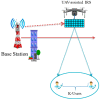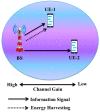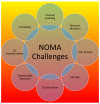A Survey of Deep Learning Based NOMA: State of the Art, Key Aspects, Open Challenges and Future Trends
- PMID: 36991657
- PMCID: PMC10058127
- DOI: 10.3390/s23062946
A Survey of Deep Learning Based NOMA: State of the Art, Key Aspects, Open Challenges and Future Trends
Abstract
Non-Orthogonal Multiple Access (NOMA) has become a promising evolution with the emergence of fifth-generation (5G) and Beyond-5G (B5G) rollouts. The potentials of NOMA are to increase the number of users, the system's capacity, massive connectivity, and enhance the spectrum and energy efficiency in future communication scenarios. However, the practical deployment of NOMA is hindered by the inflexibility caused by the offline design paradigm and non-unified signal processing approaches of different NOMA schemes. The recent innovations and breakthroughs in deep learning (DL) methods have paved the way to adequately address these challenges. The DL-based NOMA can break these fundamental limits of conventional NOMA in several aspects, including throughput, bit-error-rate (BER), low latency, task scheduling, resource allocation, user pairing and other better performance characteristics. This article aims to provide firsthand knowledge of the prominence of NOMA and DL and surveys several DL-enabled NOMA systems. This study emphasizes Successive Interference Cancellation (SIC), Channel State Information (CSI), impulse noise (IN), channel estimation, power allocation, resource allocation, user fairness and transceiver design, and a few other parameters as key performance indicators of NOMA systems. In addition, we outline the integration of DL-based NOMA with several emerging technologies such as intelligent reflecting surfaces (IRS), mobile edge computing (MEC), simultaneous wireless and information power transfer (SWIPT), Orthogonal Frequency Division Multiplexing (OFDM), and multiple-input and multiple-output (MIMO). This study also highlights diverse, significant technical hindrances in DL-based NOMA systems. Finally, we identify some future research directions to shed light on paramount developments needed in existing systems as a probable to invigorate further contributions for DL-based NOMA system.
Keywords: Channel State Information (CSI); NOMA; Successive Interference Cancellation (SIC); deep learning; massive connectivity; resource allocation; spectral efficiency.
Conflict of interest statement
The authors declare no conflict of interest.
Figures













References
-
- 3GPP Telecommunication Management; Self-Organizing Networks (SON): Concepts and Requirements; 3GPP TS 32.500 V8.0.0; December 2008. [(accessed on 20 November 2022)]. Available online: https://www.arib.or.jp/english/html/overview/doc/STD-T63v9_20/5_Appendix....
-
- Aliu O.G., Imran A., Imran M.A., Evans B. A survey of self organisation in future cellular networks. IEEE Commun. Surv. Tutor. 2012;15:336–361. doi: 10.1109/SURV.2012.021312.00116. - DOI
-
- 3GPP Telecommunication Management; Self-Organizing Networks (SON); Self-Healing Concepts and Requirements; 3GPP TS 32.541 V10.0.0; March 2011. [(accessed on 5 December 2022)]. Available online: https://www.etsi.org/deliver/etsi_ts/132500_132599/132541/10.00.00_60/ts.... - DOI
-
- Islam S.R., Avazov N., Dobre O.A., Kwak K.S. Power-domain non-orthogonal multiple access (NOMA) in 5G systems: Potentials and challenges. IEEE Commun. Surv. Tutor. 2016;19:721–742. doi: 10.1109/COMST.2016.2621116. - DOI
-
- Vaezpour E., Majzoobi L., Akbari M., Parsaeefard S., Yanikomeroglu H. A Deep Learning-Based Approach for Cell Outage Compensation in NOMA Networks. IEEE Open J. Veh. Technol. 2022;3:149–166. doi: 10.1109/OJVT.2022.3164685. - DOI
Publication types
LinkOut - more resources
Full Text Sources

